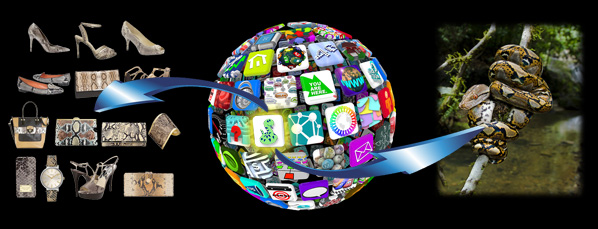European entrepreneurs develop mobile app connecting consumers to nature.
Python hunters, tanneries, luxury brands, regulators and customers will be able to share value and data.
(first released by UNEP on 26 November 2013)
Geneva/Brussels, 27 November 2013 - Your bag in python skin, where is it from? For five long nights, 40 European entrepreneurs and business coaches worked side by side with wildlife experts to craft a system of a new kind – one that can respond to that simple question by tracing the origin of a wildlife product, for instance from the collection of a snake to the luxury products made from its precious skin. ‘ASKING', a new smartphone application could help ensure the sustainable use of many species for food, medicine or fashion products.

NEST'up, the startup accelerator of Creative Walloniacollaborated on a pro bono basis with officials from the Secretariat of the Convention on International Trade in endangered species of wild fauna and flora (CITES), which is administered by the UN Environment Programme (UNEP). Both teams are united in one objective: to help find practical and cost-effective solutions to better trace snake skins, confirm their legal origin and ensure the long term survival of the species.
John E. Scanlon, Secretary-General of CITES, analyzing the preliminary results of the initiative, said: “This is a very special collaboration that blends the expertise of CITES staff with the entrepreneurial flair of the private sector. We are particularly enthusiastic about the very pragmatic solutions that have been found - solutions that have the potential to both conserve critically important wildlife and support local jobs.”
During the short but intense working period in which both groups of experts put heads together, the Startup Heroes of NEST'up developed a smartphone application that can trace snakes and snake products to confirm their legal origin: the hunter takes a photo of the snake he just collected, which in turn generates a unique tracking number for that specimen. The tracking number is automatically registered in a central database.
On a smartphone, the hunter enters the weight, length, location, and other relevant data already automatically captured in the database. With the simple stroke of a pen, he can write on the snake’s skin the ID number generated. The database is accessible to all actors in the chain from hunter to tanner thus ensuring that throughout the process, anyone along the chain can add information related to skin colour, location, new photos obtained and more.
Olivier Verbeke, Managing Director of NEST'up is very pleased that what he calls a 'rock'n roll' approach has proven very successful. Commenting on the experience, he said: 'We've put this in place in less than a month; I'm proud we have delivered what we promised we would. The very specific methods that we apply to boost up startups have worked and we have helped a wildlife cause. I was moved to see for instance developers keeping coding until 3.00AM, putting all their energy in and making sure we could provide innovative solutions. I hope such initiatives will be replicated in the future as I'm convinced accelerator techniques can help international organisations and big companies'.
Better tracing will help consumers to distinguish between legal and illegal products by creating a higher level of reliability and precision of the CITES permit system. The application will also facilitate the work of customs authorities who will be better equipped to confirm legal shipments and identify fraudulent suppliers at the borders. More importantly, a robust system will support species conservation efforts, the livelihoods of local communities, and reward law-abiding companies.
This pilot initiative fits very well within the overall efforts CITES is undertaking to better use innovation and cutting edge technologies to help countries implement their commitments under the Convention. The latest publication by the World Economic Forum - Global Agenda Council on Governance for Sustainability 'Green Light' - incubates some of the solutions that could be developed (see: /eng/news/sundry/2013/20131104_wef_greenlight.php).
“This pioneering collaboration between entrepreneurs and CITES illustrates the importance of innovation and new technologies to achieving our goals. Wild species are used by seven billion people every day - often without realizing it. The controls put into place by CITES are critical to ensuring our most precious wildlife can be enjoyed by our children. Thanks to this joint effort, we can expect further progress in ensuring a rapid shift towards more sustainable patterns of consumption of products made from species of wild fauna and flora”, concluded Scanlon.
Notes to Editors:
NEST'up is a startup acceleration program, member of the Global Accelerator Network, co-created by Fostering Ideas asbl and Creative Wallonia on the same model as TechStars' American accelerators.
CITES (the Convention on International Trade in Endangered Species of Wild Fauna and Flora) is an international agreement between governments. Its aim is to ensure that international trade in specimens of wild animals and plants does not threaten their survival.
You want to have a better idea of how this has worked?